A voyage on ‘Brer Terrapin’, an ‘Ingrid 38’ sailing ketch designed by William Aitken, starts a boat building fad that seems to have never stopped for the writer this past thirty years. With many boats built by me since that early start, I actually designed one boat myself, I call it the ‘Bahia 34’ after my trip to Salvador, Bahia, Brasil, in 1976, this story is how it all began, right up to the actual build of the boats hull by myself. The story is really more one of international travel across three continents but still a tale of why and how the writer designed and then built his first boat hull.
The Beginning:
In 1977, having sailed with Dennis O'Brien, the boat's owner and two other crew, from Cape Town to Salvador, Brasil, I had made up my mind to continue the life style but aboard my own boat. The logic was easy, I had had a great time and at only 27, the possibility of doing it for a lot longer had its attractions, a pity that I had no boat though.
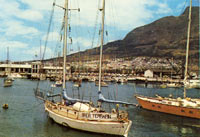 |
Brer Terrapin,moored at the Royal Cape Yacht Club,Cape Town,South Africa |
What I did have was a trade in Carpentry and Joinery, my trade test was passed back in 1968 and I had also become an associate member of the BICC (British Iinstitute of Certified Carpenters) which was based on a charter going back to 1214 ad. So logic said the boat was to be made from wood, the boat I had crossed the South Atlantic on was also wood but very heavily built from oak frames and mahogany planks, carvel construction, meaning she was planked fore and aft, with each plank laying tightly next to each other. She was double planked too.
That boat was 38ft on deck, that’s around 11.5 meters. I knew my needs would be smaller and built lighter. My favoured construction was to be ‘cold moulding’, an easy system that went back a long way but was still quite modern in 1977. My boat was to be just 34 ft long, 10.3 mtrs. That sounds like only a 4ft reduction (1,2mtrs) but in boat design, that shorter length means a great deal and saves a huge amount of expense, plus my boat would be as large inside as the boat I had just done the ocean passage on.
This was on a beach resort called Barra. It's just outside Salvador proper and north of the river mouth. The green coconuts are just the best drink you can find! |
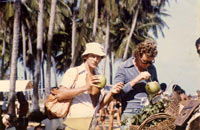 |
Why is this? ‘Brer Terrapin’, as explained, was heavily built and while her maximum beam on deck may have been around 11’-6” (3.5mtrs) her available accommodation inside was no where near that much. On each side we had planks of 1-½” plus the oak frames of 4 ½” square,making a total of 6” or 150mm, so we loose a massive 1’-0” (300mm) of usable space inside before we even start to fit her out.
To the USA
At the same time as my passage an American boat yard was producing the same design but as the ‘Aluaela 38’ and in GRP (glass reinforced plastic) or fiberglass as its more commonly known. I was at the Annapolis Boat Show in October 1976 and happened to find one of these new boats on display. Explaining my interest, I was invited aboard to see what she was like inside. The difference from Brer Terrapin was truly amazing! She was near a foot wider right away as her hull skin will have been just a ½” thick. I was also to experience another side of such a build: its lighter weight was to show a massive performance bonus when under way.
The boat was sold to a doctor from a town called Norfolk in Virginia, down river some 125 miles, I was invited to do the delivery trip as a watch captain with the new owner and the broker plus one other. We did that trip in an easy 25 hours, dodging the barges and tugs at night. It still brings back memories of search lights showing that under tow, one Tug handles four barges. We have to get out of the way and fast!
Having arrived in one of the most friendly places in America, I was now shown around and even loaned a BMW motor car so that I could travel inland. One guy I met, Charlie was his name, ran a marina and had a twin engined ski boat. He took me to see the mothballed warships and even the cruise liner ‘America’, which still held the Blue Ribbon for the fastest passage across the Atlantic, despite many offers of purchase from other countries, the boat was never sold for fear of losing the ‘Blue Ribbon’ to another country. I also saw a very sad sight that same day. Charlie took me the see the hulk of the boat ‘Atlantic’, herself a record holder in her own right, stripped of her four masts she was quite bare. The then owner failed to raise the capital required to rebuild her and eventually had her cut up. He was said to be so upset that even offers to buy her teak deck planks to be sold on as souveniers was refused. He scrapped the lot, a sad ending to a great sailing ship.
Back to England
Winter was now setting in and despite offers of accommodation from the friends I had recently made, the decision to fly back home to Liverpool was taken. I had made up my mind to build my own yacht! I took a Greyhound Bus to New York, arriving at the ‘Laker Airways’ central booking office, I walked in and asked for a ticket to Gatwick, England, on the next flight. The lady behind the counter punched a few keys on her computer, looked at the screen in front of her, then me, "You're On It’. It was as simple as that! The fare was around U$175 back then, very much a no frills trip, no food or drinks, just the plane (DC10?) but very nice cabin staff I remember.
Returning home to a cold Liverpool in the winter was a sobering thing after my recent trip. Work on Mersyside was near impossible to find. A computer searched jobs for me each day at the labour shop but never did find me a position in over six months. The time was not wasted though; I was busy each day designing my new boat. I had purchased some well known boat design books, Skenes Elements of Yacht Design,by Francis Kinney and Sailing Yacht Design, by Douglas Phillips-Birt, I found much of the information to be more technical than I could follow but started to understand the various processes of calculations.
I also discovered that some very famous yacht designers never drew their boats on paper, but made scale models. Frances Herreshoff is one such man. I think William Fife was another. This gave me much more hope; taking a wad of yachting magazines I could easily sort out a group of cruising yachts in the 34ft range, taking their principal dimentions allowed me to have a set number of common sizes between them all. Averaging them out then gave me prime numbers to work from.
Note: to do this with any success,requires you not to throw in a ‘curve ball’ by including an IOR design or 100 year old classic into your group. The designs chosen need to be similar. Even finding the mast position can be done this way, taking a half model then finding its fore and aft balance point with a pin,gives you a very good idea where the center of effort will be. I think the GRP design Moody 34 was my target design, the rest worked around that boat.
I now wanted to make a scale model, then eye ball my design and see what it was going to look like when actually built? I started by hand drawing my ideas onto paper,using a center line,the back half of the boat is on one side while the front half on the other.Once you have the lines drawn,you can ‘see’ the flow of your hull lines with great ease.At this point I have to say that when looking at ‘lines drawings’ you can not ‘see’ the boats lines,you are going to stuggle to get past this point of design? The model stage was very satisfying and I soon decided that the real boat would need more free board,once that was added in I was happy my boat would sail well.
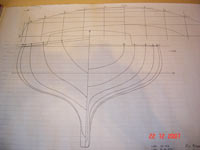 |
Drawn by me 31/10/1977 originaly in Maghull, near Liverpool, Lancashire, then r- penned down in Weybridge, Surrey, when I later went down there to work as an interior designer/draftsman. |
Note. A copy of the lines was recently submitted to a well known international yacht designer Dudley Dix, www.dixdesign.com for his comment. While he thought my design would not be as fast as his similar sized boats, he did agree that my design would sail ok. It took me thirty years to find that out!
I now had my lines drawing and a scale model taken from it. Next were the calculations of surface areas, materials to be bought in and set up the build stocks to work off. I actually got to that stage in my parents back garden but the lack of employment and the required and continued finance to build the boat was hindering me plenty. My dad arrived home one evening from work, he was always buying two daily news papers, one had a jobs vacant section, looking at what was on offer I found three of interest but down In London, the ‘big smoke’ as it was often called.
| A model of your work is so important, as at last you can see the result of your design from all angles. I took the freeboard up a little more after seeing the model. |
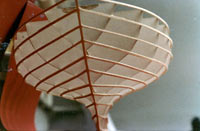 |
A move to London was never intended but on ringing the three companies advertising jobs, I found myself with three interviews, plus offers of a refund on my train fare return ticket. I was off that week and returned with two job offers. I had failed on the third due to the simple reason of myself playing neither Rugby or Golf! To start I took a position with a shopfitter in London but soon found that decent accommodation in the city was near impossible to find. The room I had rented was little more than a rat hole, so I then took up on the second offer and seventy miles south of London, to Shepperton, Surrey, what a nice place. My job as an interior designer. It was for a company in Shepperton Film Studios, owned then by the band ‘The Who’. The movie ‘Superman had just been filmed and while I was there ‘Alien’ was being filmed. All of the sets drawings went through our 'diline' printer machine. We never knew the script though and even the writer was was unsure of the script. We were told he used to dream it up while asleep, then bring it in the next day to write down.
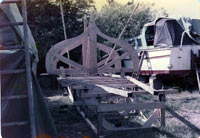 |
Setting up the frames was a great joy - Getting them from the place where I made them on my tiny Morris Minis roof, less so. |
So I now had a steady job and easily found decent digs just a short walk around the corner, so out came my yacht plans and the scale model was moved to my office for daily inspiration. One of the company (D&K shopfitters) directors allowed me ‘after hours’ access to the company workshops. My weekends were spent lofting and making the full sized frames. I then searched out a suitable building site and found a ready made one on a small island on the River Thames, not far away but across the river in Weybridge. The island was run as a boat yard by an elderly chap called Terry Tappin, he was a skilled builder of boats himself and showed me a suitable site and then left me alone to get on with my build.
| All this was the easy part. The frames in Pine would be removed later on and after the turning of the hull. |
 |
After once more setting up the same building stocks that I had used back in Liverpool a few hundred miles to the north west, I was at last about to build my first boat. Setting up the bulkheads is a great step forward and at last you can see what the actual size of your design will eventually look like. Running the stringers shows the shape of the sides even more. Starting the planking was about to be a lesson in boat design and boat building, however.
My design called for lead internal ballast, about 2800 kgs I think it was, so my hull was also part of my keel. This was to slow me down in a very big way. When the 6mm plywood strips that make the hull laminates are curved to follow the stringers in one direction, the same plank goes the other direction when you move into the keel area! My mistake and a large one,the saying ‘the man who never made a mistake,never made anything’ comes to mind here. I should have designed a bolt on steel keel shoe, this would have allowed easy lamination from the Bulwarks to the Keel area. Hindsight: whats that?
 |
All those planks were hand cut and trimed after they had been first ripped through by an electric saw. ,I had no electric tools while building. |
| Progress is good by this stage. I at least felt that I actually now owned a boat, that's a great feeling. That's my mother climbing on the boat underneath that canopy! |
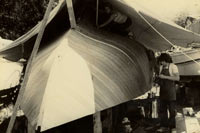 |
This in turn meant that every other plank needed edge trimming, its called ‘spliling’ in the boat trade. I had no power jig saw, so each plywood strip was hand sawn then planed with a long jack plane, meaning lots of extra labour, slowing the boat building down lots. My original idea was to do three laminations of 6mm, for a total of 18mm or ¾”, plenty for such a boat. By the end of lamination number two, I could see I had a fine looking hull but again winter was on its way and thoughts of no progress in winter started me to think of warmer places and with more financial return for the next season, as winter was on its way.
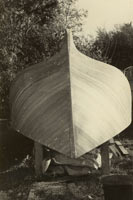 |
The second layer of plys really gave me a super fair finish, remarkable for my first build. |
On to the Sudan
A company called Dalgety had a farming project on in the Sudan, south of Kartoum, near Wad Medini and closer still to Damazin, a huge hydro electric dam complex. Dalgety wanted a project manager to run the construction of the buildings on a new cash crop farm, sponsored by the Saudi family member Prince Mohammed. He alone had put in four million US$ of his own personal wealth to the project. As soon as my connections with South Africa were known, I was asked to take on the job but politics kept my lips sealed while I was on site.
| Prince Mohamed, talking to Kerry, an Australian, the farms vet, watched by an advisor and Sandy, a Scotsman and the farm manager. |
 |
The work was testing and full of odd things like no labour that actually wanted to work, all of the trained staff had understudies but of the local labour we did have, none would take orders from an understudy, only the principal! So it was in the Sudan I learnt to drive a JCB front loader and use it's backhoe, lay bricks, plastering, even plumber works, including laying of the drains, it was I who flushed the very first waterbourne toilet on the farm.
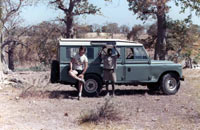 |
Our local transport, plus one of the trainee managers we had on site. |
We had some great Yamaha Agg Bikes, about 200cc engine sized and very much suited for rough travel on the terrain we had. A Sunday off was always a bike trip into the plains and mountains to see what lay beyond our farm. One work day a main pipe burst on our water tank, as all water was being hauled by our Bedford all wheel drive army type truck and water tanker trailer. The Blue Nile was some sixty miles away and to loose any water was close to disaster. We needed tools and fast, I jumped onto my Agg bike and sped off across the velt as fast as its 200cc motor would take me.
| An old train. You should have seen the state of the tracks they ran on, laid in Queen Victorias day for sure! |
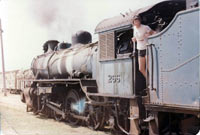 |
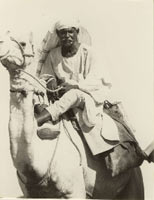 |
We found our farm was right in the old trade route across the Sudan, the camel trains that came through took days to pass some times. |
And Finally to Cape Town
I knew nothing much after that, only waking up from a concussion and having a broken coller bone. My trip was over for now. What happens next is out of my hands. My company secretary in Kartoum, knowing my South African connections, booked me a ticket to fly to Cape Town. The terms of employment were quite clear on this. I had to leave the country to get better medical care and as my first tour of duty was near at an end, why not go to Cape Town and relax and holiday at the same time? I was never going to say no to a free ticket to Cape Town. After a flight via Addis Ababa, Eithiopia, Kenya, Rhodisia, I finally find my self at DF Malan airport, Cape Town.
Arriving unannounced as I did, what to do next was the main issue. A taxi was called I jumped in and said ‘take me to the ‘Stags Head Hotel’, Hope Street, Cape Town and off we went. The drive is a good half hour if not more, which gave me time to think things through. One of which was going to be how to pay for the taxi when we arrived at the Stags Head. I had no south African currency at all!
The Stags Head was owned by a family friend, Tina but run by her son in-law Tony Lupton, well known as a top goalkeeper for Hellenic FC in Cape Town. We had also been flat mates and business partners before the sailing trip. Arrival at the pub was a gamble as I had hoped to find Tony and explain my position, borrow some cash from the till and pay off the taxi driver. Entering the mens bar I ask for Tony, who I was told is at home. Explaining to the barman who I am, I ask for some cash from the till (I still wonder about this) No problem he says and hands over a wad of notes and I then go outside and pay off the driver. While I am doing the paying, Tony has been phoned to be told of my arrival and he is on his was to the pub. Its drinks all round then!
Now I still have no place to stay, so I ring my ex girlfriend, Jean and mother of our daughter Lorna, who is then eight years old. Jean says she can drive in with her sister Mary and she duly arrives fifteen mins later, so it's more drinks all round and a great time to be back in Cape Town. While Tony is busy later at the bar, I then propose marriage to Jean, who to my surprise accepts. We then tell her sister Mary and on the basis of the good news, I am taken to Mary's home to be given a room for the night.
The next two weeks are a blur as we organize a wedding, a visit to our local hospital sees the elderly doctor listen to my story about how my collar bone was first broken, then set at a clinic in Khartoum, the doctor I saw then was from Egypt but his nurse was Scottish. She kept asking the doctor if she should fit a figure of eight bandage on me? She must have asked him three times, each time he replied ‘No’. Back in Cape Town, the doctor inspects my shoulder, then walks behind my back and placing his knee in the center of my back, places his hands on my shoulders and hauls backwards,which of course brakes the part healed bone joint, ’lets start again’ he says. The new re set bone is then given a proper 'figure of eight' bandgage, the joint heals and so well that even today I can feel no bump and wonder which side I broke.
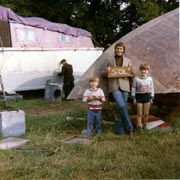 |
Two lads who used to come and watch me work, kept an eye on the boat while I was away, their mother, Pat and father Kevin arranged the actual sale through a free news paper. |
Later:
My contract in the Sudan still has a second six months to run, plus I am now a married man and Cape Town will soon be my home again. I also own a yacht hull on an island in the River Thames, now what? It's amazing how falling off a motor bike can change your life forever. In my case for the good. I soon made the decision to sell my yacht hull; I figure if I get my materials money back I can always build another. My good friends Kevin and Pam who lived just opposite the boat yard placed a small advert in a free newspaper, the hull was sold, then collected and that the last I ever heard of it!
Roy McBride
Cape Town
https://www.ckdboats.com/
|

